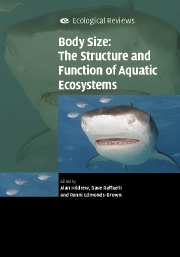Book contents
- Frontmatter
- Contents
- List of contributors
- Preface
- 1 The metabolic theory of ecology and the role of body size in marine and freshwater ecosystems
- 2 Body size and suspension feeding
- 3 Life histories and body size
- 4 Relationship between biomass turnover and body size for stream communities
- 5 Body size in streams: macroinvertebrate community size composition along natural and human-induced environmental gradients
- 6 Body size and predatory interactions in freshwaters: scaling from individuals to communities
- 7 Body size and trophic cascades in lakes
- 8 Body size and scale invariance: multifractals in invertebrate communities
- 9 Body size and biogeography
- 10 By wind, wings or water: body size, dispersal and range size in aquatic invertebrates
- 11 Body size and diversity in marine systems
- 12 Interplay between individual growth and population feedbacks shapes body-size distributions
- 13 The consequences of body size in model microbial ecosystems
- 14 Body size, exploitation and conservation of marine organisms
- 15 How body size mediates the role of animals in nutrient cycling in aquatic ecosystems
- 16 Body sizes in food chains of animal predators and parasites
- 17 Body size in aquatic ecology: important, but not the whole story
- Index
- References
17 - Body size in aquatic ecology: important, but not the whole story
Published online by Cambridge University Press: 02 December 2009
- Frontmatter
- Contents
- List of contributors
- Preface
- 1 The metabolic theory of ecology and the role of body size in marine and freshwater ecosystems
- 2 Body size and suspension feeding
- 3 Life histories and body size
- 4 Relationship between biomass turnover and body size for stream communities
- 5 Body size in streams: macroinvertebrate community size composition along natural and human-induced environmental gradients
- 6 Body size and predatory interactions in freshwaters: scaling from individuals to communities
- 7 Body size and trophic cascades in lakes
- 8 Body size and scale invariance: multifractals in invertebrate communities
- 9 Body size and biogeography
- 10 By wind, wings or water: body size, dispersal and range size in aquatic invertebrates
- 11 Body size and diversity in marine systems
- 12 Interplay between individual growth and population feedbacks shapes body-size distributions
- 13 The consequences of body size in model microbial ecosystems
- 14 Body size, exploitation and conservation of marine organisms
- 15 How body size mediates the role of animals in nutrient cycling in aquatic ecosystems
- 16 Body sizes in food chains of animal predators and parasites
- 17 Body size in aquatic ecology: important, but not the whole story
- Index
- References
Summary
Introduction
Ecologists have long been aware of regularities and patterns in the body size of organisms in populations and communities, observations that go back at least to Alfred Wallace and continue through the works of Elton, Thienemann, Hutchinson, MacArthur and many others. The classical contribution of R. H. Peters (1983) codified such patterns through the concept of body-size allometry, of metabolic rate and other features, and led on to many of the phenomena now included under macroecology (Blackburn & Gaston, 2003). Brown and colleagues (Brown et al., 2004; Brown, Allen & Gillooly, this volume), in particular, added new advances in scaling theory and, incorporating the exponential effect of temperature on metabolic rate, sought to explain a wide variety of patterns and processes in ecology at levels of organization from individuals to ecosystems.
The focus on aquatic systems at the Hatfield symposium, and in this resultant volume, is justified because body-size patterns may be more important, or at least more obvious, in aquatic ecosystems. Woodward and Warren (this volume) offer three possible reasons. First, the most important primary producers in water are small and, along with small heterotrophic micro-organisms and small detritus particles, are gathered from suspension by larger consumers. Second, they point out that conventional predators, larger in turn than their prey, seem particularly prominent in aquatic systems where there may be fewer parasite food chains (see Cohen, this volume).
- Type
- Chapter
- Information
- Body Size: The Structure and Function of Aquatic Ecosystems , pp. 326 - 334Publisher: Cambridge University PressPrint publication year: 2007
References
- 2
- Cited by



